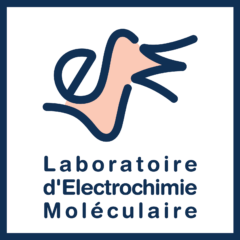Nanobody-guided redox and enzymatic functionalization of icosahedral virus particles for enhanced bioelectrocatalysis
Résumé
Icosahedral, 30 nm diameter, grapevine fanleaf virus (GFLV) virus particles are adsorbed onto electrodes and used as nanoscaffolds for the assembly of an integrated glucose oxidizing system, comprising the enzyme pyrroloquinoline quinone-glucose dehydrogenase (PQQ-GDH) and ferrocenylated polyethylene glycol chains (Fc-PEG) as a redox cosubstrate. Two different GFLVspecific nanobodies, either fused to the enzyme, or chemically conjugated to Fc-PEG, are used for the regio-selective immunodecoration of the viral particles. A comprehensive kinetic characterization of the enzymatic function of the particles, initially decorated with the enzyme alone shows that simple immobilization on the GFLV capsid has no effect on the kinetic scheme of the enzyme, nor on its catalytic activity. However, we find that co-immobilization of the enzyme and the Fc-PEG cosubtrate on GFLV does induce enzymatic enhancement, by promoting cooperativity between the two subunits of the homodimeric enzyme, via "synchronization" of their redox state. A decrease in inhibition of the enzyme by its substrate (glucose) is also observed.
| Origine | Fichiers produits par l'(les) auteur(s) |
|---|
